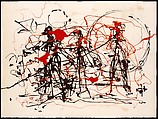Untitled
Jackson Pollock American
Not on view
From 1942, when he had his first one-man show at Peggy Guggenheim's New York gallery, "Art of This Century," until his death in an automobile crash at age forty-four in 1956, Jackson Pollock's volatile art and personality made him a dominant and revolutionary figure in the art world. Even long dead, his celebrity survives in the large body of work that is disseminated around the globe. One cannot speak about Pollock's late work—especially his famous mural-size paintings, such as Autumn Rhythm (MMA 57.92), without acknowledging his reinvention and appropriation of drawing processes.
In the mid-1940s, when he became dissatisfied with representational art, Pollock began to conceive of a way to render things imagined, rather than things that were seen. In 1947, he devised a radically new technique whereby paint was dripped and poured (as well as spattered, flung, and pooled) over canvas or paper using a variety of unconventional tools (e.g., sticks, brush handles, cans, etc.). Although such works employed paint media, his means of applying this media and his reliance on line as his primary means of expression brought these works into the realm of drawing. They redefined the parameters of traditional painting and drawing, and proposed instead a new and innovative direction for modern art. As Lee Krasner, Pollock's wife and fellow Abstract Expressionist painter, noted, his work "seemed like monumental drawing, or maybe painting with the immediacy of drawing—some new category" (quoted in B. H. Friedman, Jackson Pollock: Energy Made Visible, New York, 1972, p. 182).
This large untitled work on paper displays the great control and facility that Pollock also applied to his considerably larger canvases. Dripping skeins of bright red enamel over a linear understructure of black ink, his hand moved like a virtuoso around the sheet. Lines thicken and thin, punctuate and envelop, with poetic grace. The dynamic abstract composition that results embodies a sense of harnessed energy and rapid motion.
Due to rights restrictions, this image cannot be enlarged, viewed at full screen, or downloaded.

